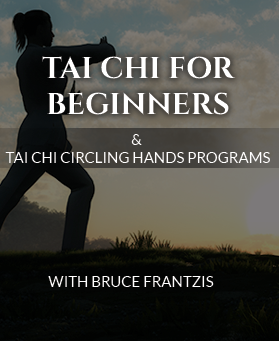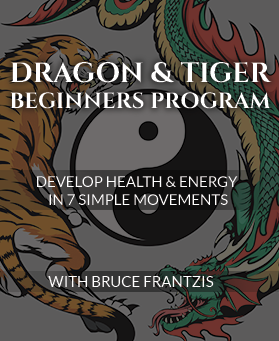The path of learning tai chi can be an exhilarating adventure. It can also be frustrating and full of pitfalls. There will be inevitable bumps and detours along the way, but it will always be your willingness to relish each point along your tai chi journey that allows you to travel well. It’s wise to focus on the journey and not the destination, but then again, if you plan to travel far, it always pays to have a good map … and a reliable vehicle.
The following is a brief look at how a student can best navigate the progression of learning the forms of the Wu Style Tai Chi of the Energy Arts System as taught by Master Bruce Frantzis. There are many ways to climb up a mountain, but this path and progression gives a student the greatest odds of developing genuine skill in tai chi, as well as a fulfilling, lifelong practice.
Tai Chi: Three Forms
There are three primary “vehicles” employed to travel this path, the Wu Style Short, Medium, and Long Forms.
All forms are containers or vehicles for learning and manifesting the internal skills (or neigong) contained within. They’re not ends unto themselves and should never be treated as such. It’s where those vehicles can take YOU that matters, not the vehicles themselves. A beat up, well driven, reliable car can get you where you’re going far better and faster than a flashy Ferrari with a great paint job, but no battery or engine.
Wu Style Short Form
The ideal starter vehicle in the Energy Arts System is the Wu Style Short Form. The Short Form is a sophisticated distillation of the first several primary postures of Wu style tai chi. It provides a great container for beginners to start exploring the neigong in the postures, yet is equally valuable to more advanced long-term students as a way of continuing to deepen their internal skill and practice—all without the heavy time and space involved in Long Form practice.
Master Frantzis was taught, empowered, and encouraged by his teacher, Liu Hung Chieh, to create short forms that would be more easily absorbed and practiced by Western tai chi students. The Wu Short Form yields a large amount of the benefits of a traditional Long Form when infused with sound neigong skills, but is more easily learned and able to be practiced in a more economical amount of time and space.
Wu Style Medium Form
After learning the Wu Style Short Form, a student progresses to the Wu Style Medium Form, also known as the “Wu Style Transformational Form.” The Medium Form deepens and extends your practice, dramatically upgrades the neigong within your tai chi, and acts as a bridge to learning the complete Wu Style Long Form.
The physical movements of the Medium Form bring new opportunities to strengthen the legs and balance, while also incrementally extending the duration of practice. It is also designed to take the fundamental skill of opening and closing to a new level, beyond what is possible in the Wu Short Form alone. One of Master Frantzis’ most referenced quotes from the time he spent with his teachers is China is, “Without opening and closing, there is no tai chi.” This is a core skill that cannot be overstated, and the Wu Medium Form is the vehicle to take the next leap forward with this neigong in your tai chi.
So why is the Medium Form dubbed the “Transformational Form”? Because, when learned, it BECOMES your new, upgraded Short Form. It also happens to be the next step in learning the complete Wu Long Form.
Wu Style Long Form
The Wu Style Long Form is composed of three parts. The movements of the first third of the form are largely contained within the Short Form. The Medium Form adds important movements taken from the second and third sections of the Long Form. For this reason, learning the Medium Form IS the next phase of learning the Long Form, but in a complete package of its own that allows you to upgrade, extend and deepen your existing practice.
Keeping the focus on the neigong within the container of your form without the burden of adding huge amounts of choreography provides optimum benefit toward building and optimizing the qi, strength and health of your body. Many students make this their final practice, opting to continue to deepen their neigong skill within the compact container of the Medium Form.
Why Not Jump Straight into Learning the Long Form?
A student who has taken the time to fully absorb and digest their Medium Form will build the internal skill and movement base for rapid, solid progress in the Long Form. You can’t take an algebra class until you can add, subtract and divide. When you have the skill, you can absorb the material, and magnify the effect of the experience and your long-term potential. Your Long Form will have content and depth, rather than being a long dance of empty movements.
You will also have gained an upgraded Short Form practice for those days when there’s simply not enough time to tackle the Long Form. Ever have one of “those” days? The Medium Form is your best friend in these moments, providing a more comprehensive practice and “juice” than the Short Form, but in a more compact container than the Long Form.
The Short Form BECOMES the Medium Form, which in turn BECOMES the Long Form. That’s why it’s known as the Transformational Form.
With the Short and Medium Forms solidly embodied, you then have the best possible platform for your study of the Wu Style Long Form. The Long Form is the key to unlocking the ultimate potential that can be realized through solo, Wu style forms practice. This is the full traditional form passed to Master Frantzis by his teacher, Liu Hung Chieh, who in turn learned the form directly from the Wu style founder, Wu Jien Chuan and his sons. It’s rare in any era to have the opportunity to study a form so closely linked to its undiluted source in a pure form.
A traditional Long Form weaves the postures and neigong they contain into an exquisite orchestra, where the combined effect is much greater than the sum of the notes. The precise composition of the Wu Style Long Form, when well played by a student who has taken the time to develop genuine skill, multiplies the benefit of your tai chi practice beyond what many back-to-back repetitions of a short or medium form are capable of. However, it is only your diligence in manifesting genuine neigong through proper practice that allows this benefit to be realized. Otherwise, the Long Form becomes a prolonged dance of empty beauty. Better a small plate of delicious and nourishing food, than an unlimited buffet of frenzied and futile chewing.
Short, Medium and Long … done always with a focus on the neigong the postures contain rather than the container itself. This is how the Wu style tai chi of Energy Arts is learned and practiced. Smooth travels and enjoy your journey!




